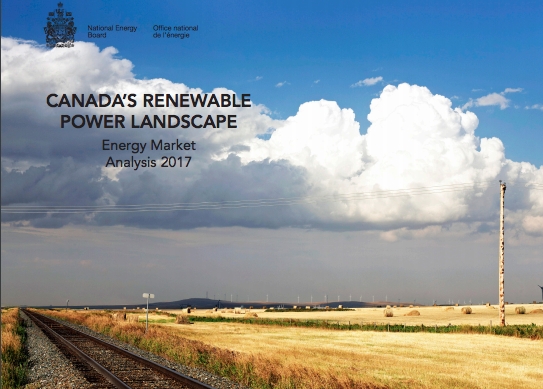
Biomass among renewable power sources increasing in Canada: NEB
December 20, 2017
By National Energy Board
Dec. 20, 2017 - Canada's non-hydro renewable power capacity grew by more than eight per cent in 2016, adding nearly 1,300 megawatts (MW) of solar, biomass and wind-generated power, according to the National Energy Board's (NEB) 2017 update of the Canada's Renewable Power Landscape report.

In 2016, Canada’s electricity generation was 66 per cent renewable, with non-hydro renewables accounting for 7.2 per cent and hydro accounting for 58.8 per cent. When nuclear power generation is added, a total of 80.6 per cent of Canada’s electricity was non-emitting in terms of greenhouse gases.
The long term trend in Canada since 2005 has been increased power generation from natural gas and wind, and decreased generation from coal.
In 2016, total Canadian natural gas-fired power generation actually dropped due to decreases in British Columbia, the Northwest Territories, Manitoba, Ontario, and Newfoundland and Labrador. However, in Alberta, Saskatchewan, New Brunswick, and Nova Scotia, natural gas generation increased as part of these provinces’ ongoing transition away from coal.
“Since 2005, the electricity sector has cut its greenhouse gas emissions by one-third, even though Canada’s total emissions only fell by 2.2 per cent in that same time period,” NEB chief economist Shelley Milutinovic said. “While hydro will remain Canada’s dominant source of power, we continue to see impressive gains in non-hydro renewable capacity from wind, solar and biomass.”
The NEB monitors energy markets and assesses Canadian energy requirements and trends to support its regulatory responsibilities. This report is part of a series of publications on energy supply, demand, and infrastructure that the NEB publishes regularly as part of its ongoing market monitoring.
Quick facts:
- Wind was the dominant source of new non-hydro renewable capacity. Across Canada, 830 MW of new wind capacity was added in 2016, while 463 MW of solar and biomass capacity was added.
- Between 2005 and 2016, coal generation decreased from 16.1 per cent to 9.3 per cent of Canada’s total generation, while natural gas generation increased from 6.8 per cent to 9.6 per cent.
- Contrary to longer term trends, Canada’s net natural gas capacity and generation decreased in 2016, primarily due to retirement of the Burrard Thermal Generating Station in B.C. (approximately 900 MW).
- Nuclear power, currently located exclusively in Ontario and New Brunswick, supplied an average of 14.7 per cent of Canada’s electricity from 2005 to 2016, and was the second largest source of total generation.
- Consistent with many Canadian and international organizations, the NEB considers energy to be renewable if it is derived from natural processes that are replenished at a rate that is equal to or faster than the rate at which they are consumed. This includes hydro, tidal, wind, biomass and solar power.
- Nuclear power is not renewable but is considered non-emitting with respect to greenhouse gases.
- Capacity is the term used to define the maximum electric output a facility can produce, and can be measured in MW. Generation is the process of producing electricity by transforming other forms of energy using this capacity. Generation also describes the amount of electricity produced, and can be measured in gigawatt hours (GW.h). A watt hour is the electricity made or used by a one watt device for one hour.
Read the full report, Canada’s Renewable Power Landscape 2017.
Print this page